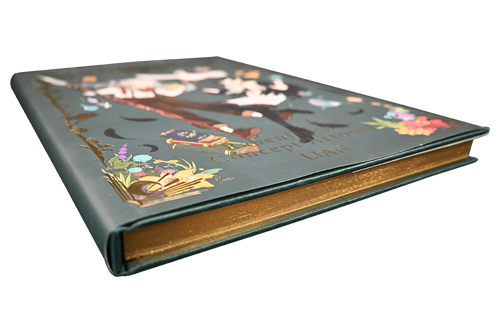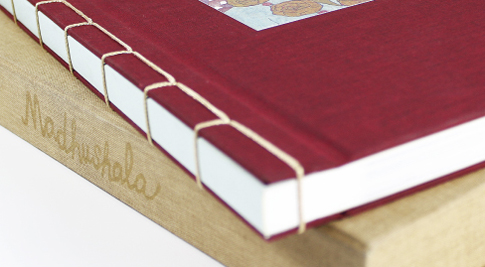Perfect Color Accuracy for a Premium art book Look
Perfect Color Accuracy for a Premium art book Look
Blog Article
Navigating the World of Art Book Printing: Tips and Techniques for a Remarkable End Up
When it comes to art book printing, you need to blend creativity with technical know-how for the very best results. You'll encounter choices that can make or break your project, from choosing the best printing technique to choosing paper that improves your artwork. Before you complete anything, there's a necessary action that can save you from costly mistakes. Let's discover what that is and just how it can boost your art book.
Recognizing the Printing Refine
When you immerse yourself worldwide of art book printing, recognizing the printing process is critical for attaining your preferred results. Begin by acquainting on your own with different printing methods, like electronic and balance out printing. Each technique has its strengths, so consider your task's scale and budget.
Following, take note of color monitoring. Make sure your pictures remain in the right color account, as this impacts how they'll show up in print. You'll also intend to select the ideal resolution-- 300 DPI is common for top notch prints.
Constantly request a proof prior to the final print run to catch any kind of errors or inconsistencies in shade. Understanding these elements can greatly improve the top quality and overall look of your art book.
Picking the Right Paper
Picking the best paper can substantially impact the general appearance and feeling of your art book. You'll want to assess variables like weight, texture, and surface. A much heavier weight paper can offer your images a much more glamorous look, while lighter documents may really feel much more fragile.
Appearance plays a crucial role also; shiny paper improves colors and detail for vibrant images, while matte paper provides a much more restrained and artistic appearance. Consider exactly how you want your artwork to be viewed-- do you like sharp contrasts or softer sides?
Do not neglect to examine examples prior to making a decision. This will certainly aid you envision just how your art interacts with different documents. Remember, the appropriate selection can boost your book from ordinary to remarkable, ensuring your creative vision shines via in every web page. So take your time, discover alternatives, and pick intelligently for the ideal outcomes.
Discovering Binding Alternatives
When it concerns binding your art book, you've obtained a number of options to ponder that can impact both the feel and look of your job. Consider the toughness features you require, in addition to the cost effects of each binding technique. Choosing the right binding can raise your artwork and assure it lasts for many years ahead.
Kinds Of Binding Methods
There are a number of binding methods to ponder for your art book, each offering distinct advantages and appearances. If you're trying to find a sleek coating, perfect binding is a superb choice, giving a professional appearance with a sturdy spinal column. For a more creative touch, take into consideration spiral binding; it enables your book to lay level, showcasing your artwork magnificently. If you favor a conventional feeling, case binding provides you a durable hardcover alternative, ideal for premium prints. Saddle sewing is another choice, excellent for thinner books and offering a clean and minimalistic appearance. Each binding method has its appeal, so think of your book's function and target market to pick the one that ideal matches your vision.

Choosing Resilience Features
After considering the various binding approaches, it's time to concentrate on toughness functions that can improve the longevity of your art book. Picking a durable binding option is necessary; think about options like case binding or lay-flat binding, which give additional stamina. Additionally, pay attention to the kind of sticky used; a top quality PVA adhesive can ensure the pages remain safe in time. If you anticipate your book to withstand frequent handling, decide for materials like laminated covers or coated paper, which withstand wear and tear. Ultimately, believe regarding how you'll keep the book-- using a safety slipcase can add an added layer of defense versus dust and damages. Focus on these features to maintain your art book looking pristine.
Cost Effects of Binding
While choosing a binding alternative for your art book, it's essential to ponder how each option impacts your spending plan. Various binding types-- like ideal binding, saddle stitching, or hardcovers-- differ significantly in cost. Perfect binding supplies a professional look however can be pricier due to the glue used. Saddle stitching is a lot more affordable, excellent for smaller sized books, yet it could not hop over to here match larger projects. Hardbound binding, while resilient and visually enticing, commonly extends your budget additionally. Remember to stabilize your creative vision with your financial restraints. Assess your target market and printing quantity, as mass orders might decrease overall expenses. Eventually, selecting the right binding alternative can boost your art book's presentation without damaging the bank.
Creating for Print
When designing for print, you need to focus on clarity and visual influence to successfully display your artwork. Start by selecting a shade palette that enhances your pieces, ensuring it equates well theoretically. Shades may appear differently in print than on-screen, so select colors that maintain vibrancy when printed.
Use high-resolution photos to avoid pixelation; go for a minimum of 300 DPI for peak high quality. Consider your typography carefully-- pick fonts that improve your art without subduing it. Keep an equilibrium between text and visuals, guaranteeing that neither distracts from the various other.
Take note of layout and white area, as these aspects lead the audience's eye and develop an unified circulation. Assume about the dimension and dimensions of your book; it should enhance your artwork, not constrict it. By concentrating on these facets, you'll develop a spectacular print design that captivates your audience.
Proofing Your Art Work
When you've completed your design, it's time to proof your art work to confirm everything looks as planned. Beginning by looking for any spelling or grammatic mistakes, as these can take away from your message. Next off, examine color accuracy. If your artwork is vibrant on-screen, however boring on paper, adjustments may be required. It's additionally necessary to review picture resolution; low-resolution pictures can appear pixelated, wrecking the overall high quality.
Publish a test proof to see exactly how your design converts to paper. This step provides important insights right into shade, comparison, and layout. Do not hesitate to request comments from relied on peers or coworkers-- they might capture problems you neglect. Lastly, make certain your art work sticks to any kind of details standards your printer needs, such as bleed and trim lines. An extensive proofing procedure guarantees that your end product reflects your effort wonderfully.
Dealing with a Printer
When you prepare to publish your art book, locating the best printer is essential. You'll need to clearly interact your vision and recognize the printing specs to ensure whatever transforms out as anticipated (art book). Let's discover exactly how to make this process smooth and successful
Choosing the Right Printer
Picking the right printer can make all the difference in bringing your art book vision to life. Research neighborhood and on the internet printing firms, paying interest published here to their profiles and customer reviews. You want a printer experienced in art books, as they'll understand the subtleties of recreating your artwork consistently.
Interacting Your Vision
To guarantee your art book comes out equally as you imagine, it's vital to connect your vision clearly with your printer. Start by sharing your imaginative idea, including styles, shades, and any details elements you desire highlighted. Review the total feel you're going for, whether it's contemporary, typical, or progressive. Be open regarding your budget plan and timeline; this helps your printer offer practical alternatives. Don't wait to share samples or recommendations that inspire you. Ask concerns and ensure you comprehend their procedures, as this constructs a collaborative partnership. Finally, develop normal check-ins during manufacturing to ensure everything lines up with your expectations. Clear interaction can change your vision right into a concrete masterpiece.

Understanding Printing Requirements
With your vision clearly articulated, it's time to concentrate on the technological side of publishing your art book. Understanding printing requirements is essential for accomplishing the best outcome. Start by reviewing your wanted paper type; choices like glossy or matte can substantially influence the visual allure. Next off, consider the book's measurements-- basic dimensions are commonly much more affordable, yet custom sizes can enhance your one-of-a-kind design. Do not neglect to inspect the resolution of your photos; they ought to go to the very least 300 DPI for crisp prints. Lastly, clarify your shade preferences-- CMYK is conventional for print, while RGB is utilized for digital. By recognizing these requirements, you'll ensure a smoother collaboration with your printer and a sensational final item.
Marketing Your Art Book
Advertising your art book successfully can make all the difference in reaching your target market and improving sales. Are they art lovers, enthusiasts, or pupils? Showcase your art work, share behind-the-scenes content, and involve with your fans via stories and blog posts.
Consider hosting a launch event or joining art fairs to get in touch with potential purchasers directly. Work together with influencers or bloggers in the art area to broaden your reach. Do not underestimate the power of email advertising and marketing; build a newsletter to keep interested visitors upgraded.
Finally, take advantage of online marketplaces and your website for straight sales. Deal minimal versions or special promotions to develop seriousness. By combining these strategies, you'll boost exposure and drive sales for your stunning art book.
Often Asked Concerns
What Is the Ordinary Price of Art Book Printing?
The average cost of art book printing differs commonly based upon aspects like size, web page count, and products. Normally, you're looking at anywhere from $10 to $50 or more per book, relying on your choices.
How much time Does the Printing Process Generally Take?
The printing procedure normally takes regarding 2 to 4 weeks, relying on the job's complexity and quantity. You'll need to consider layout, proofing, and possible revisions to ensure every little thing satisfies your assumptions.
Can I Print a Minimal Version of My Art Book?
Yes, you can publish a restricted version of your art book. Just determine the number of copies you want, choose a quality printer, and this post guarantee you've got the ideal products to develop a special feeling.
What File Formats Are Best for Publishing My Art Work?
For printing your art work, usage high-resolution files like TIFF or PDF. These styles keep quality and color accuracy. Prevent JPEGs for final prints, as they can lose information. Always examine your printer's requirements for best results.
How Can I Guarantee Color Accuracy in My Printed Book?
To ensure color accuracy in your printed book, utilize an adjusted screen, soft evidence your data, and pick a trusted printing service. Take into consideration utilizing RGB or CMYK color modes as needed for your art work.
Report this page